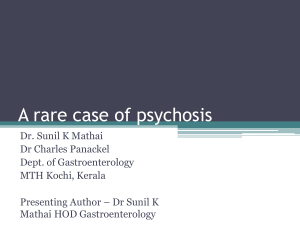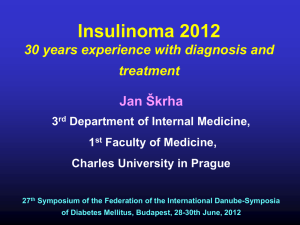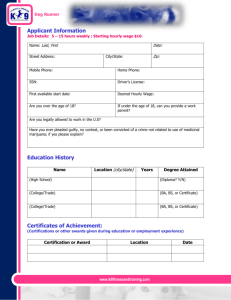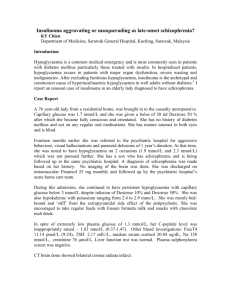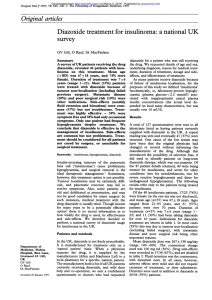Insulinoma - Saint Francis Veterinary Center
advertisement
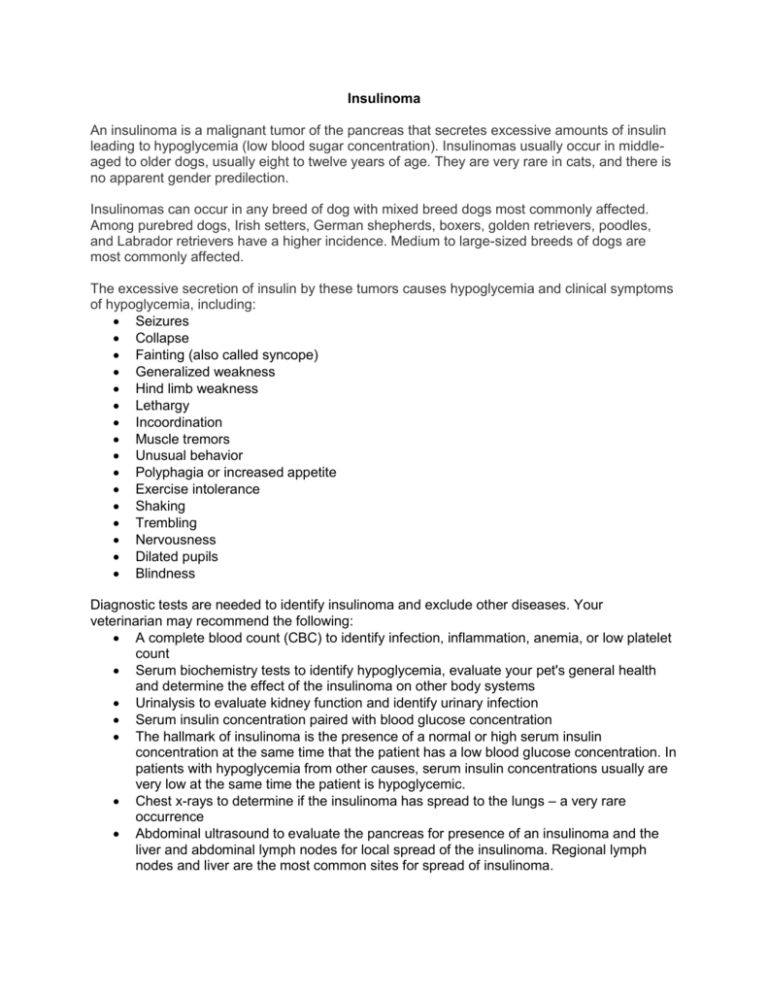
Insulinoma An insulinoma is a malignant tumor of the pancreas that secretes excessive amounts of insulin leading to hypoglycemia (low blood sugar concentration). Insulinomas usually occur in middleaged to older dogs, usually eight to twelve years of age. They are very rare in cats, and there is no apparent gender predilection. Insulinomas can occur in any breed of dog with mixed breed dogs most commonly affected. Among purebred dogs, Irish setters, German shepherds, boxers, golden retrievers, poodles, and Labrador retrievers have a higher incidence. Medium to large-sized breeds of dogs are most commonly affected. The excessive secretion of insulin by these tumors causes hypoglycemia and clinical symptoms of hypoglycemia, including: Seizures Collapse Fainting (also called syncope) Generalized weakness Hind limb weakness Lethargy Incoordination Muscle tremors Unusual behavior Polyphagia or increased appetite Exercise intolerance Shaking Trembling Nervousness Dilated pupils Blindness Diagnostic tests are needed to identify insulinoma and exclude other diseases. Your veterinarian may recommend the following: A complete blood count (CBC) to identify infection, inflammation, anemia, or low platelet count Serum biochemistry tests to identify hypoglycemia, evaluate your pet's general health and determine the effect of the insulinoma on other body systems Urinalysis to evaluate kidney function and identify urinary infection Serum insulin concentration paired with blood glucose concentration The hallmark of insulinoma is the presence of a normal or high serum insulin concentration at the same time that the patient has a low blood glucose concentration. In patients with hypoglycemia from other causes, serum insulin concentrations usually are very low at the same time the patient is hypoglycemic. Chest x-rays to determine if the insulinoma has spread to the lungs – a very rare occurrence Abdominal ultrasound to evaluate the pancreas for presence of an insulinoma and the liver and abdominal lymph nodes for local spread of the insulinoma. Regional lymph nodes and liver are the most common sites for spread of insulinoma. Treatment of acute insulinoma must be individualized based on the severity of your dog's condition and other factors that must be analyzed by your veterinarian. Treatments may include surgery, medical management, or a combination of both. Surgical removal Surgery is usually the first approach to management, and allows the possibility of cure for a dog with a single, easily removable tumor. Unfortunately, the tumor has usually spread to other abdominal sites, often the liver and regional lymph nodes, by the time a diagnosis is made, and surgery is only a temporary help. If the entire tumor is not removable, or if there has been spread to other organs, removal of as much abnormal tissue as possible usually results in remission of the symptoms of hypoglycemia and improves the response to medical therapy. Emergency Treatment At Home If your dog is having a hypoglycemic seizure, administer a sugar solution, such as Karo syrup or sugar water by mouth. Lightly pour the sugar solution directly into your dog's gums; do NOT place your fingers near the teeth of a seizuring dog as your pet may inadvertently bite you during the seizure. Most pets will respond within 30 seconds to 2 minutes. If your dog responds to the emergency treatment with the glucose solution, give him a small, high protein meal once the seizure subsides and the animal is sitting up and aware of his surroundings. Long-term therapy Long-term medical therapy is instituted if surgery is declined, the tumor cannot be completely removed, or the tumor has spread to the liver and regional lymph nodes. Also, if a large amount of the tumor was removed surgically and clinical symptoms were controlled initially but have now reappeared, long-term therapy should be initiated, consisting of: Dietary therapy if a constant source of calories is provided as a substrate for the excessive insulin, hypoglycemia and its associated clinical symptoms can be minimized. Diets high in protein and complex carbohydrates are recommended. Feed a combination of canned and dry food in several small meals throughout the day. Exercise should be limited to short leash walks. Simple sugars should be avoided because they rapidly stimulate insulin secretion. Feed your dog immediately at the first sign of hypoglycemia like weakness, incoordination, collapse, muscle tremors. Feed him/her a regular diet because administering honey or corn syrup will only delay hypoglycemia. A more severe episode could occur 30 to 120 minutes later as the simple sugar in the honey or corn syrup stimulates additional insulin release from the tumor. Honey or corn syrup should be reserved for emergency situations and generalized seizures. Glucocorticoids (cortisone-like drugs) When dietary manipulations alone are not effective in preventing signs of hypoglycemia, glucocorticoids should be administered. Your veterinarian will instruct you on how to increase the dosage of prednisone to control the clinical symptoms. Dogs may develop adverse effects as a result of prolonged and excessive glucocorticoid treatment (excessive water consumption, increased urinations, increased appetite, panting, weight gain, hair loss). If these effects occur, your veterinarian may lower the dosage of prednisone and add diazoxide. Diazoxide Diazoxide inhibits the secretion of insulin from beta cells. It also stimulates the liver to produce more glucose. The end result is a rise in the blood sugar concentration. Administration of the diuretic hydrochlorothiazide may potentiate the effects of the diazoxide, and the two drugs may be administered together if diazoxide alone is ineffective. Unfortunately, diazoxide is fairly expensive, and it can difficult to obtain. Somatostatin analogues (Octreotide) Somatostatin is a hormone made by the pancreas that inhibits the synthesis and secretion of insulin by normal and malignant beta cells. Its inhibitory action on insulin secretion can be maintained for several hours. Not all dogs respond well to somatostatin analogues, such as octreotide, and some dogs respond initially but become refractory later. Streptozotocin Streptozotocin selectively destroys pancreatic beta cells. It can cause severe kidney damage unless intensive intravenous fluid therapy is provided first. It is an investigational drug, and owners should provide informed consent before its use. The estimated success rate in insulinoma using streptozotocin is 30 percent. Alloxan Alloxan also is toxic to pancreatic beta cells, and it also can cause severe kidney damage in dogs. A study of eight dogs showed initial control of hypoglycemia in four dogs for several months, but hypoglycemia eventually recurred in the four dogs that responded. Adriamycin Adriamycin has been effective in some human patients with insulinoma, but its efficacy for insulinomas in veterinary patients is not known. Home Care and Prevention Optimal treatment for your dog requires a combination of home and professional veterinary care. Follow-up can be crucial. Administer as directed any medications prescribed by your veterinarian. Follow dietary recommendations made by your veterinarian. Feed frequent small meals of a high carbohydrate diet to maintain adequate blood sugar concentration. Observe your dog's general activity level, appetite and attitude. Watch for recurrence of clinical symptoms of hypoglycemia that may indicate recurrence of the tumor. Administer corn syrup orally if you see signs of hypoglycemia, such as seizures, weakness, or muscle tremors. Keep your dog's exercise and activity level relatively constant. Avoid intensive exercise or provide high carbohydrate snacks before exercise. You can prevent a hypoglycemic crisis by following the dietary, exercise, and medical recommendations of your veterinarian. Schedule regular follow-up visits with your veterinarian to monitor your dog's progress, and promptly identify any recurrence of hypoglycemia and insulinoma. Blood sugar concentration should be monitored. Development of hypoglycemia often indicates a return of the tumor or spread to regional lymph nodes or liver. Prognosis An average survival time of one year was found in one study of 114 dogs with insulinoma treated by surgery followed by medical therapy when symptoms recurred. Occasionally, dogs with insulinoma will live as long as two years after diagnosis and treatment. The survival rate may in fact be even better, since 31 of the dogs were still alive at the conclusion of the study. A more recent study of 28 dogs with insulinoma found an average survival time of 547 days. The average survival for dogs undergoing partial pancreatectomy was 785 days and for those whom subsequently relapsed and then received steroids the average survival was 1316 days.
